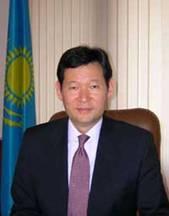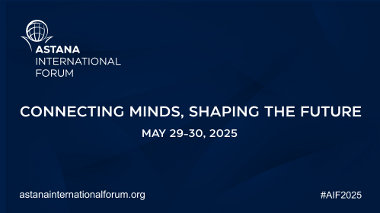 The United States was the first country to recognise our independence and establish diplomatic relations with Kazakhstan in December 1991. During the short period since then, bilateral cooperation has intensified in almost all areas and the relationship between the two countries has been firmly established at the level of strategic partnership.
The United States was the first country to recognise our independence and establish diplomatic relations with Kazakhstan in December 1991. During the short period since then, bilateral cooperation has intensified in almost all areas and the relationship between the two countries has been firmly established at the level of strategic partnership.
Political dialogue at the highest level creates the necessary conditions to further strengthen mutually beneficial cooperation with the current U.S. administration. The constructive and cordial relationship between the two leaders, Nursultan Nazarbayev and Barack Obama, is one of the most important facilitators of the growing partnership. Our leaders meet each other annually on the margins of various international events. The previous such meeting took place during the G20 summit in St. Petersburg in September 2013. The leaders also regularly exchange messages on contemporary issues. The close and trust-based relationship between the two leaders was once again reaffirmed during their recent phone conversation, which covered strategic partnership issues and the situation in Ukraine.
As President Obama pointed out in his congratulatory message to our head of state on the occasion of our Independence Day last year, although the strategic partnership between our countries “is young, it continues to develop, reflecting the cooperation between our governments and people.” Given the United States’ recognition of Kazakhstan’s international leadership in nonproliferation, the next meeting of our leaders is scheduled to take place during the Nuclear Security Summit in The Hague on March 24-25. The meeting will give the leaders an opportunity to compare notes on topical issues on the bilateral and international agendas. President Obama has said he appreciates President Nazarbayev’s leadership on nuclear nonproliferation, which has led to “growth and prosperity in his own country.”
American experts also note the successes of Kazakhstan’s diplomacy. Frederick Starr, chairman of the Central Asia-Caucasus Institute at Johns Hopkins University, believes that “Kazakhstan has managed to do what no other country has done: maintain cordial and balanced strategic partnerships with China, Russia and the United States.” In his opinion, “U.S. links with Kazakhstan are among this country’s most promising relations in the Muslim world.”
Richard Weitz, senior fellow and director of the Centre for Political-Military Analysis at the Hudson Institute, notes that “Kazakhstan’s growing role in its extended neighbourhood advances significant U.S. interests.” He states that through “its increasing economic engagement in Eurasia – which has involved direct investment and trade as well as support for improving regional commercial and transportation infrastructure – Kazakhstan is helping transform Central Asia and the Caspian region into an ‘arc of opportunity’ rather than an ‘arc of crisis.’”
A visit by Kazakhstan’s Foreign Minister Erlan Idrissov to the U.S. in July 2013 gave a significant impetus to the development and strengthening of bilateral cooperation and was groundbreaking in a number of key directions.
The co-chairmanship of the Strategic Partnership Dialogue Commission was elevated to the heads of foreign ministries. Among all Central Asian states, the U.S. has established a Strategic Partnership Dialogue Commission only with Kazakhstan, while with other countries in our region Washington conducts annual bilateral consultations. Another main outcome of the visit was the launch of the mutual issuance of five-year visas from August 1, 2013. The high level and intensity of the foreign minister’s meetings with heads of key U.S. agencies indicated recognition of Kazakhstan’s growing political importance by official Washington as well as its readiness to be Kazakhstan’s partner in implementing the Kazakhstan 2050 Strategy and the National Concept of the Transition to a Green Economy through the participation of advanced corporations.
The November 2013 visit to Washington, D.C., by Minister of Defence Adilbek Dzhaksybekov acquired a critical urgency in the context of the U.S. troop withdrawal from Afghanistan in 2014. During the visit, Dzhaksybekov and U.S. Secretary of Defence Chuck Hagel and other officials had a comprehensive exchange of views on regional security issues, as well as the strengthening of military and technical cooperation.
It is also important that contacts were established with enterprises of the U.S. defence industry complex and bilateral military-technical cooperation was brought to a qualitatively new level.
As a practical follow-up to the meetings, a number of major U.S. defence companies plan to take part in the KADEX defence technology exhibition in Astana in May 2014.
Overall, cooperation in this area is developing in accordance with the third five-year plan for military cooperation for the period 2013-2017, which was signed in November 2012.
The plan provides for the development of peacekeeping capacities (including through the Steppe Eagle military exercises); assistance in the field of military education; the establishment of contacts between defence companies and training for special operations units of Kazakhstan’s armed forces, including psychological training.
In the law enforcement sphere, the official visit of Prosecutor General Askhat Daulbayev to Washington last December, the first in the history of bilateral relations, and his meetings with the U.S. Attorney General and the head of the FBI laid a good foundation for the development of a constructive partnership.
Interparliamentary relations have also been revitalised and mutual visits of parliamentary delegations take place.
The unprecedented participation of 30 U.S. congressmen and senators in the Kazakhstan-American Conference and the reception on the occasion of Kazakhstan’s Independence Day in December 2013 is evidence of the growing interest in our country.
The number of members of Congress in the Friends of Kazakhstan Caucus on Capitol Hill is growing.
A parliamentary delegation led by Deputy Speaker of the Senate of Kazakhstan Alexander Sudyin visited Washington in May 2013 to mark the 10th anniversary of the success of the initiative of our President to convene and host the Congress of Leaders of World and Traditional Religions.
In honour of Kazakhstan’s delegation, Congressman Eni Faleomavaega handed to Senator Sudyin his Congressional Record statement recognising Kazakhstan’s contribution to promoting interfaith dialogue. The U.S. congressman thanked Kazakhstan and President Nazarbayev for his initiative to convene the Congress of Leaders of World and Traditional Religions 10 years ago, noting that today “it has become an effective forum in which the leaders of world religions may promote a unified approach to achieving the most important goal – the establishment of inter-religious dialogue.”
Kazakhstan and the U.S. continue to maintain dialogue on nuclear nonproliferation. The Americans have always appreciated Kazakhstan’s contributions in this area, singling out Kazakhstan as an example for other countries. Most recently, U.S. Senator Ed Markey chose to announce his introduction of the SANE Act (Smarter Approach to Nuclear Weapons Expenditure) to the Senate at a reception organised by the Embassy of Kazakhstan in the historic Kennedy Caucus Room of the U.S. Senate. This indicates the value he places on cooperation with Kazakhstan in the field of nuclear nonproliferation and disarmament. The reception was part of the PNND (Parliamentarians for Nuclear Non-Proliferation and Disarmament) Assembly, where Kazakhstan’s delegation included Senator Byrganym Aitimova and member of the Mazhilis of Kazakhstan Viktor Rogalev, as well as representatives of the online education and petition initiative, the ATOM Project.
The relocation of the International Science and Technology Centre in Kazakhstan, as well as the creation of the International Atomic Energy Agency’s low-enriched uranium fuel bank and the construction of the Central Reference Laboratory in Almaty are among the breakthrough projects in the field of nonproliferation coming in the near future. Another of Kazakhstan’s concrete contributions to nonproliferation, the U.S. believes, came in the hosting of two rounds of talks between Iran and the six nations of international mediators in Almaty, which helped launch the actual mechanism of a diplomatic resolution to the Iranian nuclear programme.
Our two governments pay special attention to creating favourable conditions for the development of investment and trade and economic cooperation. The volume of U.S. foreign direct investment in Kazakhstan in the first half of 2013 amounted to $1.2 billion, 12.8 percent more than in the same period in 2012. Most American foreign direct investment goes to the mining industry (18 percent), real estate and business services (16 percent), the financial sector (5 percent) and activities of professional organisations and industry associations (3 percent).
Mutual trade during the nine months of 2013 amounted to $1.9 billion, which is 5.6 percent more than that of the first nine months of 2012. Major American companies such as Boeing, General Electric, Hewlett-Packard and others have accomplished their business plans in Kazakhstan. Some companies have been successful in establishing joint ventures. One success story is the joint venture of GE Transportation and Kazakhstan Temir Zholy to manufacture locomotives. As part of its strategy of business expansion, this joint venture plans to manufacture and assemble diesel engines.
American companies are also leaders in terms of investment in Kazakhstan’s energy sector. The Joint Kazakh-American Commission on energy partnership plays an important coordinating role in energy cooperation between the two countries. It aims to develop and implement a detailed and concrete action plan in all areas of energy partnership. The work of the commission over the past years has shown that cooperation in the field of renewable energy, energy efficiency and clean energy technologies is becoming increasingly important. In a short period of time, both sides have managed to establish a permanent expert dialogue and advanced to implementing specific projects. The 10th meeting of the commission is scheduled to take place this year.
An important event in Kazakhstan-U.S. bilateral cooperation is the international exhibition EXPO 2017. The main theme of the exhibition corresponds to the long-term objectives that U.S. President Barack Obama has set for his country, namely achieving full development of energy-saving and alternative energy technologies by 2033.
Work on the scientific and technological track within the framework of the Kazakhstan-U.S. Strategic Partnership Commission and its establishment in the form of a separate Joint Commission on Scientific and Technological Cooperation last year facilitated important steps in the development of long-term cooperation in this area. The inaugural meeting of the commission took place in June 2013 in Astana, which resulted in the adoption of a joint action plan for 2013-2015. In recent years, the number of U.S. industrial and manufacturing companies interested in entering Kazakhstan’s market has grown.
Today, the United States sees Kazakhstan as a reliable partner and a regional leader in Central Asia, a country that effectively transmits domestic successes into the world arena and makes significant contributions to global and regional security.
President Nazarbayev’s state-of-the-nation address, “Kazakhstan 2050 Strategy: New Political Course of the Established State,” has been positively received by U.S. official, analytical and business circles. The address gives a new opportunity for widening bilateral collaboration, especially in the field of investment, technology and innovation.
U.S. officials and experts believe the address is a solid and positive road map that clearly identifies Kazakhstan’s development priorities for the long term. Our focus on an innovative economy and sustainable development should give a powerful boost to the work of the Strategic Partnership Dialogue, whose agenda intersects with the ambitious goals of the 2050 strategy. We will need to maintain a dynamic foreign policy in order to reach the goals of joining the world’s 30 most developed countries and creating a favourable environment for attracting new technologies and investment.
According to American experts, implementing long-term programmes will ensure political stability and economic development. U.S. business circles also positively note the economic initiatives outlined in the address and underline the ambitious and timely priorities that will play an important role in the transformation of Kazakhstan’s economy.
The strategic partnership between Kazakhstan and the United States is experiencing a new stage of growth, exemplified by our common strategic goals and similar approaches to achieving them.
The author is the ambassador of Kazakhstan to the United States.


